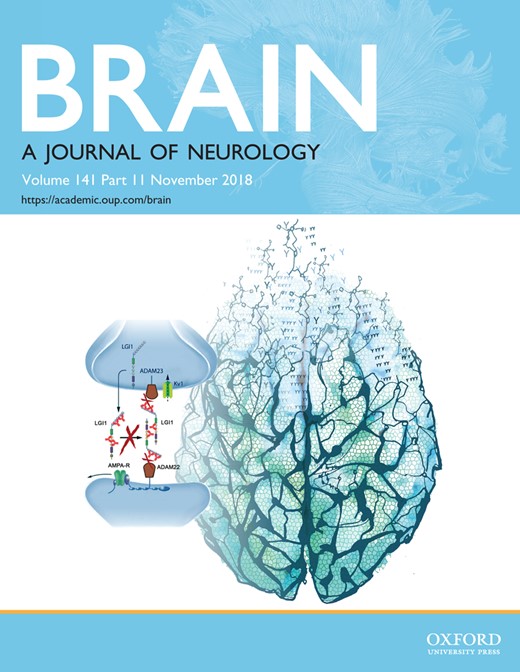
Cover image

Cover image: Pathogenic effects of LGI1 autoantibodies in the brain, on a background of mosaics inspired by Antoni Gaudí, showing that patients’ autoantibodies alter presynaptic and postsynaptic pathways related to Kv1.1 potassium channels and AMPA receptors, resulting in memory deficits. From Petit-Pedrol et al. LGI1 antibodies alter Kv1.1 and AMPA receptors changing synaptic excitability, plasticity and memory. Pp. 3144–3159.
Image by X. Lizartzategi, M. Spatola, J. Planaguma and M. Petit-Pedrol.
Volume 141, Issue 11, November 2018
Editorial
Editorial
Scientific Commentaries
PHACTRing in actin: actin deregulation in genetic epilepsies
This scientific commentary refers to ‘De novo PHACTR1 mutations in West syndrome and their pathophysiological effects’, by Hamada et al. (doi:10.1093/brain/awy246).
Multiple sclerosis: is it all black and white in optical coherence tomography?
This scientific commentary refers to ‘Brain and retinal atrophy in African-Americans versus Caucasian-Americans with multiple sclerosis: a longitudinal study’, by Gonzalez Caldito et al. (doi:10.1093/brain/awy245).
Pre- and postsynaptic effects of LGI1 autoantibodies in a murine model of limbic encephalitis
This scientific commentary refers to ‘LGI1 antibodies alter Kv1.1 and AMPA receptors changing synaptic excitability, plasticity and memory’, by Petit-Pedrol et al. (doi:10.1093/brain/awy253).
Listening for the rhythm of a conscious brain
This scientific commentary refers to ‘Robust EEG-based cross-site and cross-protocol classification of states of consciousness’, by Engemann et al. (doi:10.1093/brain/awy251).
Original Articles
De novo PHACTR1 mutations in West syndrome and their pathophysiological effects
See Eid et al. (doi:10.1093/brain/awy272) for a scientific commentary on this article.
West syndrome is characterized by infantile spasms with intellectual disability. Hamada et al. identify two de novo heterozygous missense mutations in PHACTR1 in affected individuals. In vivo and in vitro analyses suggest that PHACTR1 mutations cause morphological and functional defects in cortical neurons during brain development.
Brain and retinal atrophy in African-Americans versus Caucasian-Americans with multiple sclerosis: a longitudinal study
See Aly and Korn (doi:10.1093/brain/awy269) for a scientific commentary on this article.
African Americans with multiple sclerosis demonstrate higher inflammatory disease activity and poorer prognosis than Caucasian Americans. Gonzalez Caldito et al. report that African Americans patients exhibit faster rates of brain and retinal tissue loss, emphasizing the need for future studies involving this group to identify individual differences in treatment responses.
n-3 Docosapentaenoic acid-derived protectin D1 promotes resolution of neuroinflammation and arrests epileptogenesis
Frigerio et al. report that pro-resolving mechanisms of neuroinflammation are dysregulated during epileptogenesis, thereby promoting a persistent neuroinflammatory response that contributes to seizure generation and cognitive deficits. Boosting endogenous resolution responses by administering a specific lipid mediator improves disease outcomes in a murine epilepsy model, suggesting a novel treatment avenue.
LGI1 antibodies alter Kv1.1 and AMPA receptors changing synaptic excitability, plasticity and memory
See Debanne and El Far (doi:10.1093/brain/awy271) for a scientific commentary on this article.
Anti-LGI1 encephalitis is the most frequent cause of autoimmune limbic encephalitis, but the antibody-related mechanisms are unclear. Petit-Pedrol et al. demonstrate in a mouse model of cerebroventricular antibody transfer that anti-LGI1 antibodies cause impairment of memory and plasticity, neuronal hyperexcitability, and decreased levels of Kv1.1 potassium channels and AMPA receptors.
HCN1 mutation spectrum: from neonatal epileptic encephalopathy to benign generalized epilepsy and beyond
HCN channels are activated by hyperpolarization, and help to control neuronal excitability. Marini et al. describe how de novo or inherited missense variants leading to loss- or gain-of-function of HCN1 are associated with a wide range of seizure disorders ranging from lethal neonatal epilepsy to benign generalized epilepsy.
Robust EEG-based cross-site and cross-protocol classification of states of consciousness
See Sokoliuk and Cruse (doi:10.1093/brain/awy267) for a scientific commentary on this article.
Detecting awareness in patients who recover from coma but remain behaviourally unresponsive is a major challenge. Engemann, Raimondo et al. demonstrate that machine learning on EEG signals enables robust classification of state-of-consciousness in data from brain-injured patients in multiple hospitals.
Dysfunctional effort-based decision-making underlies apathy in genetic cerebral small vessel disease
Le Heron et al. demonstrate, using behavioural, physiological and imaging techniques, converging evidence that reduced reward sensitivity underlies apathy in patients with a monogenic form of cerebral small vessel disease. This specific change in effort-based decision making points to potential treatment avenues for apathy.
Brain structural alterations are distributed following functional, anatomic and genetic connectivity
The pathological brain is characterized by distributed structural alterations in grey matter, which tend to follow identifiable network-like patterns. Cauda et al. investigate how different types of brain connectivity – functional, anatomical, genetic – guide the spread of structural alterations, and show that co-alterations are distributed according to brain connectivity constraints.
Incident cognitive impairment: longitudinal changes in molecular, structural and cognitive biomarkers
Roe et al. examine the time-course of biomarker changes during conversion to Clinical Dementia Rating >0. The rate of change of cognitive and structural, but not molecular, biomarkers is greater in those who progress versus do not progress. Molecular biomarkers may become abnormal earlier, consistent with theoretical models.
Face perception enhances insula and motor network reactivity in Tourette syndrome
Avolitional tics in Tourette syndrome may be worsened by stress and triggered by social cues such as the facial expressions of others. Rae et al. show that during viewing of emotional faces, the insula is hyperactive in Tourette syndrome and displays increased functional connectivity with cortical and subcortical motor regions.
Dorsal Column
Grey Matter
Brodmann: a pioneer of human brain mapping—his impact on concepts of cortical organization
On the 150th anniversary of Korbinian Brodmann’s birth, and the 100th anniversary of his death, Zilles celebrates his pioneering role in brain mapping. With the aid of hitherto unpublished documents and figures, he explains the concepts behind Brodmann’s cytoarchitectonic maps and considers their impact on current neuroimaging approaches.












